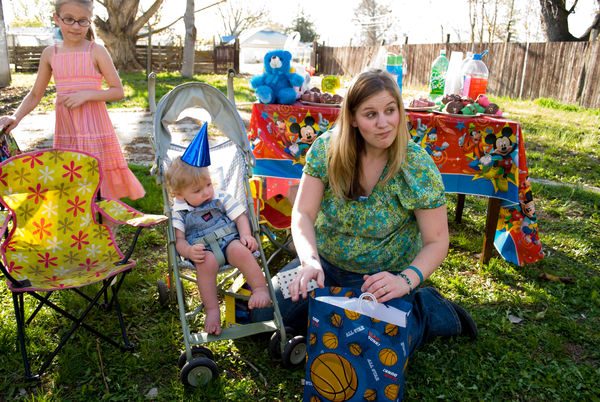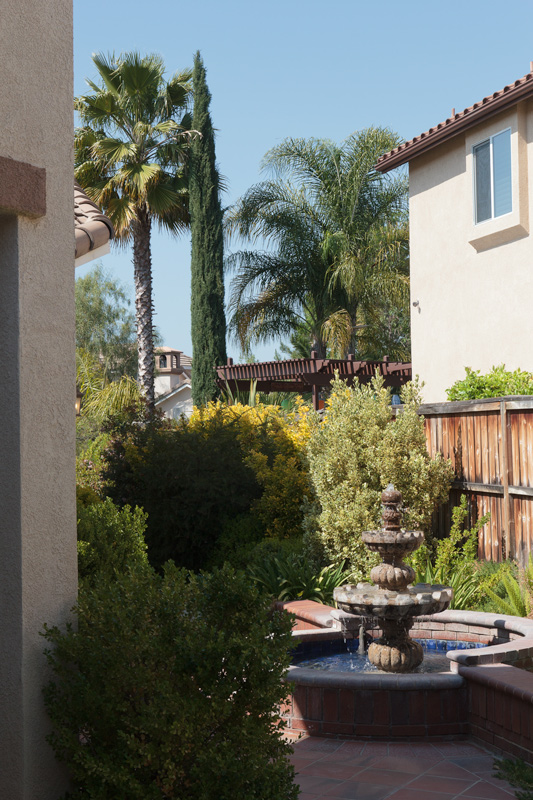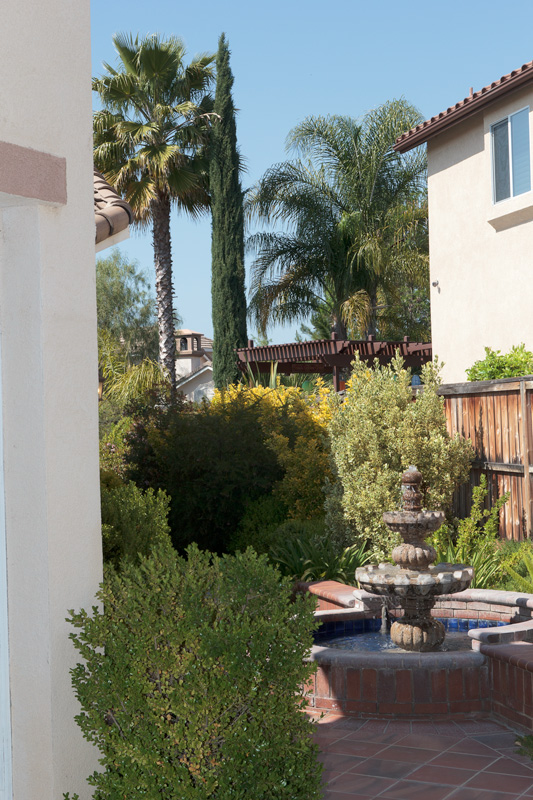Over exposure of sky problems
Apr 22, 2012 17:32:30 #
[quote=CaptainC]
This is becoming an exercise in "measure with a micrometer, mark it with a crayon, and cut it with an axe!"
quote]
Love it!
:lol:
This is becoming an exercise in "measure with a micrometer, mark it with a crayon, and cut it with an axe!"
quote]
Love it!
:lol:
Apr 22, 2012 19:02:47 #
Apr 22, 2012 19:21:03 #
Hi. Did not read the whole thread. But let me offer another editing solution that may address the overexposed sky after the fact. Use the graduated filter in Adobe Camera Raw, or later in the full Photoshop.
I took the liberty of copying and editing your picture, and then applying the GF in ACR. Notice that here, the GF darkened areas other than the sky. In ACR, when working on the larger image file, the GF functions intelligently, and avoids darkening areas other then the sky. The GF can bring back unseen image information in the sky.
If you can control your flash unit independent of the camera, then another technique can work sometimes in these situations to retain more information in the sky. Turn off the flash. Adjust camera settings for a good exposure of the sky -- or a better exposure.
You could try to keep enough exposure in the background, too, while exposing for the sky.
As another way, try putting your camera in Program (P) mode, with Auto ISO set. Do a test exposure. Note the settings for Shutter Speed, Aperture, and ISO that P mode selects.
Put your camera in Manual mode, and dial in the same settings. As a guide, say the P mode still overexposed the sky somewhat. Lower the ISO or raise the SS or make the Aperture smaller (say f/9 instead of f/5.6). Try all 3 in combinations. You might favor a smaller Aperture, say f/9, to control the overexposed area, for depth of field.
Of course, when taking pictures of children, you will want a faster SS (usually not less than 1/100 sec, but sometimes faster, like 1/160 sec).
Experiment with this technique. You can gain control over exposure using adjustment for the ambient light while adding fill flash.
Note that if you put the flash unit in ETTL mode, the camera metering system will automatically expose correctly for the main subject in the foreground.
The ambient exposure has already been set by you in the earlier sequence.
The flash lighting does not affect or otherwise change the camera settings for the ambient exposure.
Important note: Canon digital cameras do not permit Exposure Compensation with the camera in Manual mode. You will have to adjust SS, ISO, or Aperture manually in order to change exposure. In the example given here, you'd likely prefer to adjust SS slightly so as to minimize affecting the ambient exposure.
Then turn on the flash unit, and add fill flash to illuminate the main subject.
Photographers shooting models outdoor use this technique routinely.
Many photographers have difficulty grasping the concept of two exposures occurring during an overall exposure involving flash lighting. It's easy to understand.
The flash unit fires first, for several thousandths of a second, then quits. The flash contributes no more light to the exposure.
The rest of the exposure happens from the ambient light.
See the two example photographs below your shot. The first I adjusted to f/11, 1/160sec, ISO 100. The second I shot with the flash unit in the cameras hotshoe, in the ETTL mode, leaving the camera settings unchanged.
For these two photographs, I did only basic adjustments in ACR, and none in the full Photoshop.
Once you begin using flash photography, your photographic opportunities will grow. You will also achieve more control over light for better exposures.
For more instruction, try this Web site: http://neilvn.com/tangents/flash-photography-techniques/
I took the liberty of copying and editing your picture, and then applying the GF in ACR. Notice that here, the GF darkened areas other than the sky. In ACR, when working on the larger image file, the GF functions intelligently, and avoids darkening areas other then the sky. The GF can bring back unseen image information in the sky.
If you can control your flash unit independent of the camera, then another technique can work sometimes in these situations to retain more information in the sky. Turn off the flash. Adjust camera settings for a good exposure of the sky -- or a better exposure.
You could try to keep enough exposure in the background, too, while exposing for the sky.
As another way, try putting your camera in Program (P) mode, with Auto ISO set. Do a test exposure. Note the settings for Shutter Speed, Aperture, and ISO that P mode selects.
Put your camera in Manual mode, and dial in the same settings. As a guide, say the P mode still overexposed the sky somewhat. Lower the ISO or raise the SS or make the Aperture smaller (say f/9 instead of f/5.6). Try all 3 in combinations. You might favor a smaller Aperture, say f/9, to control the overexposed area, for depth of field.
Of course, when taking pictures of children, you will want a faster SS (usually not less than 1/100 sec, but sometimes faster, like 1/160 sec).
Experiment with this technique. You can gain control over exposure using adjustment for the ambient light while adding fill flash.
Note that if you put the flash unit in ETTL mode, the camera metering system will automatically expose correctly for the main subject in the foreground.
The ambient exposure has already been set by you in the earlier sequence.
The flash lighting does not affect or otherwise change the camera settings for the ambient exposure.
Important note: Canon digital cameras do not permit Exposure Compensation with the camera in Manual mode. You will have to adjust SS, ISO, or Aperture manually in order to change exposure. In the example given here, you'd likely prefer to adjust SS slightly so as to minimize affecting the ambient exposure.
Then turn on the flash unit, and add fill flash to illuminate the main subject.
Photographers shooting models outdoor use this technique routinely.
Many photographers have difficulty grasping the concept of two exposures occurring during an overall exposure involving flash lighting. It's easy to understand.
The flash unit fires first, for several thousandths of a second, then quits. The flash contributes no more light to the exposure.
The rest of the exposure happens from the ambient light.
See the two example photographs below your shot. The first I adjusted to f/11, 1/160sec, ISO 100. The second I shot with the flash unit in the cameras hotshoe, in the ETTL mode, leaving the camera settings unchanged.
For these two photographs, I did only basic adjustments in ACR, and none in the full Photoshop.
Once you begin using flash photography, your photographic opportunities will grow. You will also achieve more control over light for better exposures.
For more instruction, try this Web site: http://neilvn.com/tangents/flash-photography-techniques/
With graduated filter applied in ACR

Ambient light only

Ambient light with fill flash

Apr 22, 2012 19:38:29 #
I pretty much think that the Captn nailed it. Just take the best snap shots you can and don't stress...the camera can't do everything in every situation.
Apr 23, 2012 12:19:22 #
anotherview wrote:
Hi. Did not read the whole thread. But let me of... (show quote)
Thanks for that explanation and examples..and the link. I will try the P mode example next time I take my camera out and see how I can do.
Apr 23, 2012 16:25:01 #
Croce
Loc: Earth
Forget a neutral density filter, your little girl would have a black head if you used it in the first photo and in the 2nd the sky is almost totally inconsequential. The truth of the matter is there is NO WAY to solve the problem in the pics you showed, in Camera. An ND filter can help with a somewhat regular horizon and a polarizer can often help as can fill flash, but if what you showed is from where you usually shoot, forget it. Newfie has the right philosophy. Take it to heart and enjoy.
Apr 23, 2012 21:20:13 #
Croce: May I respectfully disagree?
First setting the camera for a corrrect exposure of the sky, and then adding fill flash, as earlier described, can go a long way toward an improved overall exposure.
Further, another technique, called High Speed Sync (which I haven't tried yet), changes the flash unit output to a series of smaller light bursts. These bursts light the main subject.
In addition, HSS allows setting a higher Shutter Speed to control a bright sky.
David Hobby, a master strobist, discusses this and other flash lighting techniques on his Web site:
http://strobist.blogspot.com/2006/03/lighting-101.html
First setting the camera for a corrrect exposure of the sky, and then adding fill flash, as earlier described, can go a long way toward an improved overall exposure.
Further, another technique, called High Speed Sync (which I haven't tried yet), changes the flash unit output to a series of smaller light bursts. These bursts light the main subject.
In addition, HSS allows setting a higher Shutter Speed to control a bright sky.
David Hobby, a master strobist, discusses this and other flash lighting techniques on his Web site:
http://strobist.blogspot.com/2006/03/lighting-101.html
Croce wrote:
Forget a neutral density filter, your little girl would have a black head if you used it in the first photo and in the 2nd the sky is almost totally inconsequential. The truth of the matter is there is NO WAY to solve the problem in the pics you showed, in Camera. An ND filter can help with a somewhat regular horizon and a polarizer can often help as can fill flash, but if what you showed is from where you usually shoot, forget it. Newfie has the right philosophy. Take it to heart and enjoy.
Apr 24, 2012 00:00:49 #
...soooo how dark do you want that middle ground to be?
By the time you get that lit too, it will past the kids' bedtime, let alone missing the spontaneity of the moment, which is what makes the photo.
By the time you get that lit too, it will past the kids' bedtime, let alone missing the spontaneity of the moment, which is what makes the photo.
Apr 24, 2012 03:16:27 #
Croce
Loc: Earth
Hi another, Sure you can disagree and what you propose can be done but I'll just bet the lady does not care to take on the challenges of becoming a master strobist, encumbering herself with technical minutea. She is a photo snapping mom spontaneously recording the moment to moment, ever changing, joys of her growing children. If she had her druthers she would probably prefer to do it with a P & S or cell phone camera. She wants her eye on the children not on her camera setup. There are many ways to skin a cat but for this one I have to hang in Newfs camp.
Apr 24, 2012 06:31:59 #
Apr 24, 2012 07:46:59 #
Apr 24, 2012 10:06:43 #
Croce: May I respectfully disagree again?
Reviewing the text from the original post, I found this expression: "it takes a lot of time to fix them all and it would be nice to just have it right in camera."
This expression indicates the shooter wants to advance beyond the status of snapshooter to competence in doing photography. Various techniques exist for getting exposure right in the camera. The dialog in this thread has offered several ways to achieve this outcome. In general, the conditions facing the photographer will dictate how to address getting a good exposure.
Nobody ever said doing photography comes easy. As a craft, photography demands attention, practice, and study, all while learning from one's mistakes. The informed guidance of others can help quicken this process.
Reviewing the text from the original post, I found this expression: "it takes a lot of time to fix them all and it would be nice to just have it right in camera."
This expression indicates the shooter wants to advance beyond the status of snapshooter to competence in doing photography. Various techniques exist for getting exposure right in the camera. The dialog in this thread has offered several ways to achieve this outcome. In general, the conditions facing the photographer will dictate how to address getting a good exposure.
Nobody ever said doing photography comes easy. As a craft, photography demands attention, practice, and study, all while learning from one's mistakes. The informed guidance of others can help quicken this process.
Croce wrote:
Hi another, Sure you can disagree and what you pro... (show quote)
Apr 24, 2012 10:34:28 #
anotherview wrote:
Croce: May I respectfully disagree again? br br ... (show quote)
Thanks for all your generous contributions...first off though..I am the grandpa of the little girl and 1 year old boy...lol...but that's ok Croce...there's no way you could have known...
I am what you would consider a semi professional photographer I guess through constant practice, continued shooting and post processing, a few years experience, what I learn here, and would like to have gotten those shots with the sky right in the camera just because I want to for whatever may happen in the future. I do get paid for some of my shooting. I'm not concerned about this particular event and I'm not going to go through and fix the sky in most of them, just trying to learn how to fix this problem though so I will seldom ever have too. This particular event turned out fine and I am not disappointed after everything I have read and the problems that my situation posed. But I think exposing for the sky, then some small adjustments for the other areas, to get a happy medium, and shooting in Raw, (and more practice), I can probably get it right enough to make it look good in post processing without having to add a sky to the image (which would take a lot of time if I had to do a lot of them). I've learned a lot and know how to adjust for many things, and my post processing gets less and less (which is the ultimate goal of getting everything right in the camera) but new ones just keep popping up, and this was one of them...
The thing I like about these kind of family events is I can mess around with settings all I want, take all kinds of different shots and not have to worry about it, and learn a lot that way...not true with a paid event though...they have to be perfect. So in this case I was a combination of a snap shooting mom, and a photographer...lol
Thanks again!
achammar
Apr 24, 2012 11:14:23 #
Croce
Loc: Earth
Achammar, you sneaky dude, you. Like a drag queen sitting back there in your wig, makeup and dress watching all us poor suckers trying to help a loving mom in distress. Shame on you!
Now that you have been properly admonished and are out of the closet I can deal with you head on. OK Achammar, screw on a polarizer, set it max, use a big flash on a bracket and fire away. Naughty, naughty grandpa.
Now that you have been properly admonished and are out of the closet I can deal with you head on. OK Achammar, screw on a polarizer, set it max, use a big flash on a bracket and fire away. Naughty, naughty grandpa.
Apr 24, 2012 11:25:38 #
Croce wrote:
Achammar, you sneaky dude, you. Like a drag queen sitting back there in your wig, makeup and dress watching all us poor suckers trying to help a loving mom in distress. Shame on you!
Now that you have been properly admonished and are out of the closet I can deal with you head on. OK Achammar, screw on a polarizer, set it max, use a big flash on a bracket and fire away. Naughty, naughty grandpa.
Now that you have been properly admonished and are out of the closet I can deal with you head on. OK Achammar, screw on a polarizer, set it max, use a big flash on a bracket and fire away. Naughty, naughty grandpa.
Lol....ya I guess so...but a damsel in distress gets more help... :-)
So, I mentioned before I have never used any attachments on my lens. I've heard of many different types of filters and have little to no experience or knowledge about any of them (guess I should do my homework). I've done everything so far without any of that. So, what is/will a polarizer do and exactly when should I use it? (Pretend like I'm still the damsel in distress)
Thanks!
If you want to reply, then register here. Registration is free and your account is created instantly, so you can post right away.




